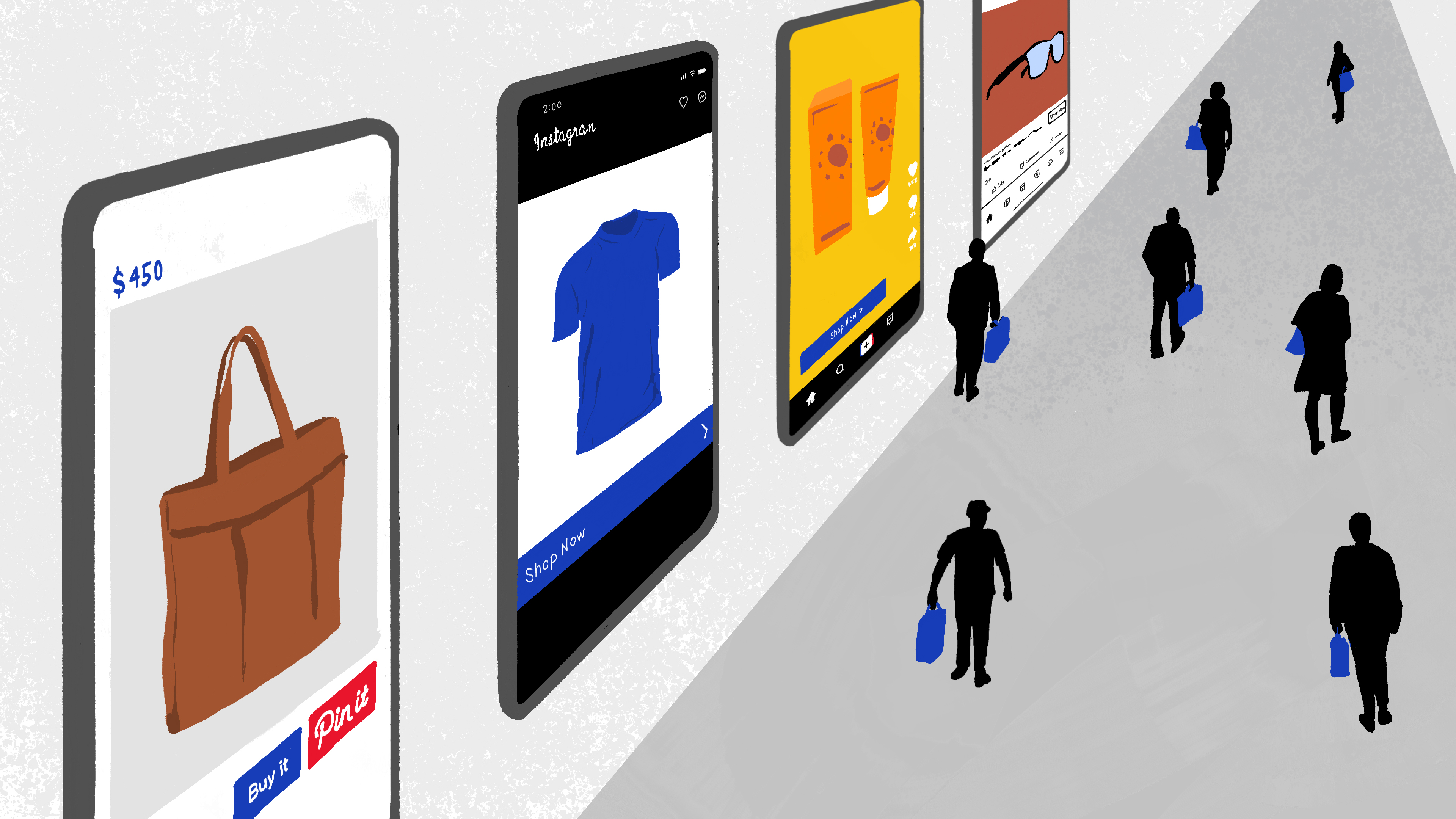
Since the rise of the digital age, social media has practically taken over everyone’s life. Let’s examine how that can benefit you and your company, as well as the best ways to sell your goods on Facebook and Instagram.
It is more likely that younger demographic groups have some sort of social media presence. While social media isn’t typically thought of as being social by nature, it makes sense to have social media profiles even if you’re not actively selling anything on them because they may serve as a venue for feedback, news, and the promotion of your business.
Social media platforms don’t serve as sales channels, but they nevertheless consume over a lot of your time with updates and other social interactions. Your presence draws a specific population, but that doesn’t ensure they’ll take the next step and visit your website to browse and shop.
According to Statista, the global social commerce market is projected to surge to over $3 trillion USD within the next eight years. Concurrently, eMarketer forecasts a steady rise in U.S. social buyers, escalating from 32.5% in 2021 to an anticipated 37.9% by 2025.
Both consumers and brands are accustomed to selling features that are integrated into apps like Instagram, and live shopping is quite popular. Companies are realizing how important it is to interact with consumers on the social media channels that they choose.
A discriminating brand strategy avoids repeating content and product discovery across channels by recognizing the unique opportunities and nuances that each platform offers.
Now, where do consumers use this new kind of buying the most? Here, we’ll examine the social commerce’s historical context, clarify its importance for consumers and companies, and highlight the varied strategies used by different platforms.
What is Social Commerce?
Selling goods and services directly through social media is known as social commerce. With social commerce, the entire purchasing process, that is from finding products to doing your research and making a purchase. All of these things take place on social media.
Instagram, Facebook, Pinterest, and TikTok are the social media platforms that now have native social commerce features built-in.
With social commerce, you could come across a pair of adorable bumble bee stockings on your Instagram feed, click “shop now,” put them to your shopping cart, and finish the transaction there in the app.
- Social networking platforms like Facebook and Instagram are used to sell goods and services as part of social commerce, a type of online business.
- The performance of social commerce initiatives is gauged by retweets, likes, and shares.
- By providing knowledgeable product guidance and help, social commerce likewise aims to attract online shoppers.
- Unlike e-commerce, which enables customers to make purchases on specific e-commerce websites and apps, social commerce does not allow this.
- The experience of social commerce includes marketing, browsing, shopping, and making purchases.

Working of Social Commerce
As previously mentioned, social commerce entails the sale of goods and services using social media. It promotes social buying platforms like forums and communities where shoppers and sellers may exchange information about their online purchasing experiences.
Social commerce is a rapidly developing industry that supports the expansion of social media and online purchasing. Blogs on fashion and shopping leverage social media and commerce to get readers to buy the associated products online.
Social media marketers design and publish interactive features and messaging that advertise online sales and other e-commerce activities.
Instagram profiles for numerous well-known fashion blogs enable fans to like, share, and comment on the merchandise presented. Frequently, the tagged article contains a direct link to the store’s shopping cart or checkout counter. A social commerce campaign’s performance is determined by consumer engagements (likes, retweets, and shares); the more of these they receive, the more successful they typically are.
Benefits of Using Social Commerce
There is no denying that there is a rising need for quick and simple internet shopping. Along with that desire, potential also exists.
There is a sizable piece of the pie available for retail firms interested in utilising social commerce solutions. Other than the potential increase in e-commerce sales, embracing social commerce has a lot of other advantages for retail firms.
Below listed are some of the benefits of using social commerce:
1. Seamless Shopping Experience
Buying over social media is made simple by features like in-app checkout, Buy buttons, and instant messaging facilities. By using social commerce, extra steps in the purchasing process can be cut out. Customers are more likely to lose interest in a purchase if there are additional steps in the purchasing process.
There is less chance of customers abandoning the app by allowing users to stay there from discovery through checkout.
2. Target Your Audience
You have a fantastic opportunity to adjust and focus your advertising thanks to the enormous abundance of client data that is available on social media.
You may instantly market your eye-catching pillow coverings to those who enjoy home design. Moreover, selling fashionable cargo pants would attract a lot of young customers.
In a way that traditional eCommerce and marketing cannot, social commerce gives you the option to put precise, ready-to-buy products in front of specific people who would enjoy them.
3. You Will Get Customer Feedback
Direct customer interaction and customer feedback on your brand and products are made simple by social media. Customers enjoy expressing their ideas because it helps them feel respected. Businesses can use polling software, comment sections, and IM applications to engage with customers.
Retailers can adjust their offerings to match client expectations by using this input. Once merchants have access to these insights, they may take appropriate action, whether it is to improve customer service, add additional product size options, or launch a new apparel line.

4. Gather More and More Data
Customer information is primarily found on social media channels. Future product development and marketing activities can benefit from this insightful data.
Instagram Insights offers demographic information, such as gender, age range, and location. Marketing professionals can learn even more specific information about their target group by using Facebook group Insights.
Retailers can create highly targeted ad campaigns with the use of this data to get their goods in front of the right customers. Brands now have an opportunity to reach highly targeted consumers with their products thanks to social commerce, something that is impossible with traditional e-commerce platforms.
Using Social Commerce with Facebook
Facebook Shops, Facebook’s social commerce service, offers a very minimal entry requirement. Shops may be accessed from your Facebook business page and are completely free to set up.
You can quickly and instantly sync your whole inventory list if you’re using a partner platform. If not, you can upload product information using a spreadsheet.
- Products are presented in the Facebook Shop section of the platform’s mobile app based on user preferences. This aids in promoting natural brand discovery.
- Customers can make a purchase on your website or in the app after discovering your stuff.
- Within Messenger, sellers speak with customers to answer issues, provide support, and more.

How to Use Facebook for Social Commerce?
- If your business already has a Facebook page, then it is a plus point. If not, one must be created.
- Once that’s taken care of, confirm that the Shopping template is being used on your website. To do this, choose Templates and Tabs from the left-hand menu by clicking Settings in the upper right corner.
- Then pick “Shopping” by clicking the Edit icon next to your current template.
- You can see a tab titled “Shop” on the left-hand side of your page now that it is using the Shopping template. Toggle that.
- Facebook will ask you for a few essential details about your e-commerce company, such as your location, the products you offer, how you prefer to be paid, and so on.
- You’ll only need a few minutes, and after you click Finish, your Facebook shop will be complete! Once Facebook has approved it and you have added at least one product, it will be available for users to browse.
Using Social Commerce with Instagram
Your Facebook Shop is immediately connected to Instagram Shopping. Users must connect their Instagram and Facebook business profiles in order to create a store. Users can then upload an existing product catalogue or build a new one after that is finished.
If you want to simplify the overall experience for your users and make it simpler for people to find your products, use Instagram product tags. You can use product tags to highlight certain goods from your product catalogue in your videos and blogs. Users can tap on a tag to get more information about a product right away.
They can browse your other listings and have a seamless shopping experience by clicking the “View shop” button. Purchases can be made within the app or on your company website, similar to Facebook.

How to Use Instagram for Social Commerce?
As you have already started a Facebook shop, then it means you are totally eligible to use Instagram. Half of your work has been done. Just to do a final set up you have to do a couple of things
- Check your account settings, connect your account to your Facebook page, and make sure it is set up as a business profile rather than a personal profile.
- Enter Facebook Ads Manager next. To access the drop-down menu, click the symbol in the upper left corner and choose Catalogues from the Assets column.
- The account evaluation procedure will start once you’ve linked your Instagram profile to the catalogue you’re using for your Facebook business. This will probably take a few days.
- Once your application has been approved for Instagram Shopping, you may begin including hashtags for the items in your catalogue in your posts and Instagram stories.
Tips to Boost Your Social Commerce
As we have discussed the benefits of social commerce and also how it can be used on Facebook and Instagram.
In this section, you will get to know some tips, so that you can boost your social commerce:
1. Engage With Your Followers: Remember, you don’t have to just throw away your catalogue and move on. Respond to inquiries, provide useful and engaging content, be genuine and human, and so on. Create a chatbot to assist customers in advancing through the shopping process.
2. AI chatbots to respond: A quick and efficient response to a customer’s query can be the difference between a sale and a cart that has been abandoned. You can automate customer service and guarantee that your clients are looked after at all times with the correct AI technologies.
3. Consider Testimonials & Reviews: Collecting testimonials is essential to establishing a good image online, whether it be through automatic follow-up emails asking for reviews after a product has been delivered or incentives like contests to persuade past clients to weigh in and share their experience.
Once you’ve received some favourable feedback, creatively promote it on your social media pages by publishing user-generated material, inviting satisfied clients to appear in a Live video, or just compiling a carousel of supportive remarks. There are other approaches to take that won’t come across as boastful.
Conclusion
Social media networks like Facebook and Instagram provide businesses a viable platform for direct product sales. With features like in-app checkout and precise targeting of potential clients, it provides a seamless purchasing experience.
Additionally, social commerce enables companies to interact directly with customers and collect insightful feedback, which helps them improve their goods and services.
Establishing an online store and starting to sell has become simple for businesses thanks to platforms like Facebook and Instagram. Businesses may increase their reach and interact with potential customers who spend a lot of time on these platforms by following a few easy steps.
Businesses need to actively engage with their followers, utilise AI tools for effective customer care, and encourage customers to submit reviews and testimonials if they want to succeed in social commerce.
Businesses can maximise online sales prospects and improve customer purchasing experiences by adopting social commerce and putting these methods into practice.





